The victories at Actium and Alexandria and the consequent suicides of Antony and Cleopatra left Octavian as the single dominant figure in Roman politics. The senators scrambled to show their loyalty: extravagant honours were voted to Octavian (Dio, 51.19-20).
The senators were not the only ones moved to praise the young Caesar. The cities of Ephesus and Nicaea dedicated precincts to Rome and (Julius) Caesar, but there seems to have been some provision for the worship of Octavian. Similarly, Pergamum and Nicomedia also developed precincts seemingly dedicated to Octavian.
There was a similar elevation underway in Rome. There was an established association of Octavian with Apollo. In the aftermath of the war of Actium, or perhaps even before, silver statues had been established for him in the city, precious metals being normally used for statues of divinity (Suetonius, Augustus 52).
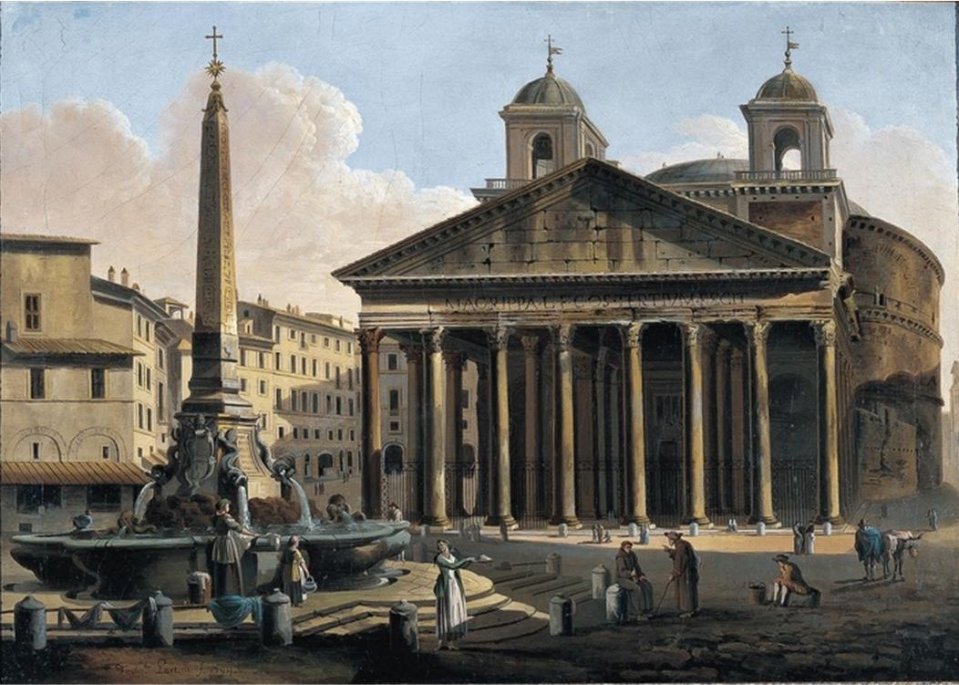
Pantheon as painted by Ferdinando Partini, 1794. (Commons: Metropolitan Museum of Art)
More spectacular as a representation was the Pantheon. This temple was under construction by Agrippa but was dedicated in 27 BC or soon after (Dio, 53.27). The intention, attributed to Agrippa, was that the building would be dedicated to Octavian and that a cult statue would be installed at its heart.
These elements suggest that the young Octavian, who had been styling himself ‘son of the deified’ for at least a decade and making use of the sidus iulium, the comet that appeared to supposedly mark the transformation of Julius Caesar into a god in his imagery.
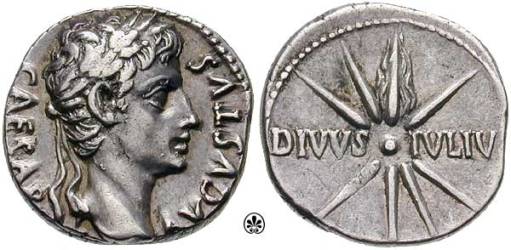
Coin of Augustus showing the sidus iulium (Classical Numismatic Group)
But in 28 BC, Octavian pulled back from this pathway to divine honours. The silver statues were melted down and the silver dedicated to Apollo. Agrippa’s temple was renamed the Pantheon, dedicated to all the gods, and Octavian’s statue was relegated to the porch, alongside that of Agrippa.
This re-thinking of his position appears to have been general, but without obvious cause. There was some evidence of opposition. Marcus Lepidus, son of the triumvir, was detected in a conspiracy by Maecenas and killed off without trial. Perhaps more seriously, one of his alleged co-conspirators was Iunia, sister of Brutus. The conspiracy and its rapid suppression hints at a nervousness at the centre of power (Velleius Paterculus, 2.88). It also suggests that there were a number of people who would never be reconciled to Octavian’s domination.
Whatever the reason for their change of heart, in 28 BC, Octavian and Agrippa began to plot a new course. They set out to normalize their authority.
The first stage of this process came with Octavian’s assumption of the consulship in January 28 BC. Octavian had been consul, for a second time, in 33, then in 31, 30 and 29. In 28 BC, he entered his sixth consulship. The consulship was meant to be a collegial office, shared with a second consul. But although there was a second consul in each of these years, it seems that Octavian monopolized the symbols of office, notable the attendants of the consuls, the lictors, who carried the fasces. But in 28, he chose to share the lictors, as was the norm, with his fellow consul, Agrippa (Dio, 53.1).
Agrippa married into the imperial family, taking Claudia Marcella to wife. He had been very much at the forefront of Octavian’s group, leading the spending on the city of Rome in 34 and 33, commanding Octavian’s fleets, and in 28 BC presiding at festivals when Octavian was ill. From 28, he was yet more closely associated with Octavian’s regime.
The normalization process continued. Octavian and Agrippa held a census, a ritual counting of the Roman people: they counted 4,063,000 Romans (Res Gestae 8). The previous year, he had revised the roll of the senate, expelling senators who had little justification for their status. This was not just an administrative act, but was also a ritual purification of the city and its citizens.
This clearing away of the irregularities of the past also led to a cancellation of some debts owed to the treasury. Renewal can also be seen in a programme of repair of public buildings. Allied to this was a programme of religious renewal and reassertion of discipline (Dio, 53.2). Augustus claims that he restored 82 temples in the city (Res Gestae 20). Although a large number of repairs might suggest a religious infrastructure fallen into decay, the procedures for the renewal and repair of public buildings in Rome (including temples) were chaotic: they relied on magistrates being interested. In the circumstances of extended civil conflict over the previous decades, the list of necessary repairs had probably built up. Of course, we cannot know just how much work was conducted in the various religious sites and it would be a mistake to assume that the 82 temples repaired had all been in a state of ruin.
Octavian continued to celebrate his victories and assert his status. The festival in honour of Actium was celebrated. He also completed and dedicated a temple to Apollo on the Palatine.
This temple seems to have been a dominating structure, significant enough to be referenced by Suetonius (Augustus 29.3), Virgil (Aeneid 8.741-48), Propertius (2.31) and Ovid (Fasti 4.951-54) . It had associated libraries of Greek and Latin books and was effectively part of Octavian’s own house. Phoebus Apollo was the god to whom credit was given for the victory at Actium and a huge victory monument had been constructed on the hillside at Actium.
A whole new city was built there, Nikopolis, which was mirrored by another Nikopolis which was built on the outskirts of Alexandria.
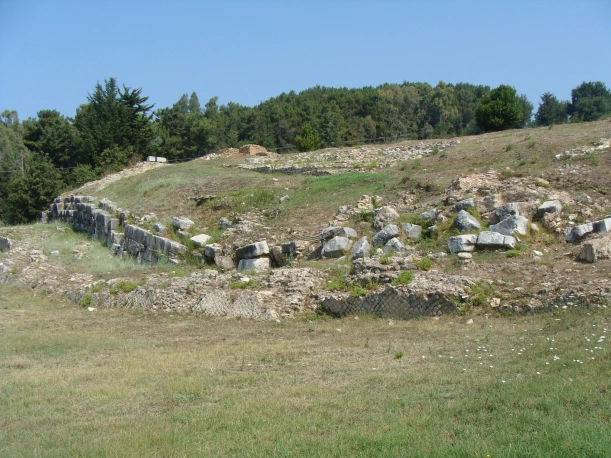
Ruins of Victory Monument Along the Hill above Actium
The Actium monument was itself was dedicated to Apollo. As Virgil makes clear, the temple in Rome was also a victory monument.
Octavian took the title of princeps senatus. This was a title of limited significance during the Republic, given to the most senior member of the senate. This man would expect to be called first in debates, but, with Octavian, it merged into his title.
There was no word to describe the power that Octavian was constructing; it was something new in Roman society. Although we talk about him as emperor, the closest Latin equivalent, imperator, simply meant general. ‘Principate’ emerged as a word to describe a period of individual imperial rule, and so we might translate principatus Augusti as ‘the period in which Augustus was the leading man’. It was much later, perhaps only under Tiberius, that we can think in the terminology of ‘reigns’.
These measures marked an end of the state of emergency that had begun with the formation of the triumvirate in 43 BC. This ending was celebrated in a coin issued in 28 BC.
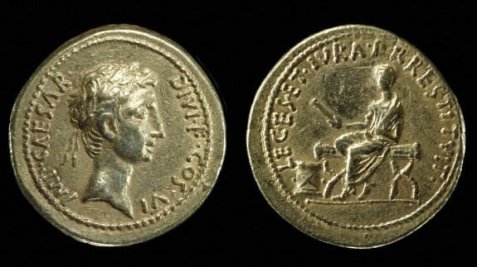
Aureus issued in 28 (British Museum)
The coin shows Octavian seated with a box of papers at his side. He is handing out a scroll. The legend read ‘leges et iura p.r. restituit’ meaning ‘he restores the laws and rights of the Roman people’. Those were the laws and rights which had been suspended in 43 BC. They included security of the person and of property. Although one might argue about what the res publica meant, one could make a case for it consisting of the rights of the Roman citizens and the rule of law. These were now restored. The Republic was restored. The triumviral emergency was over.
But the wars were not forgotten. Victory continued to be celebrated.
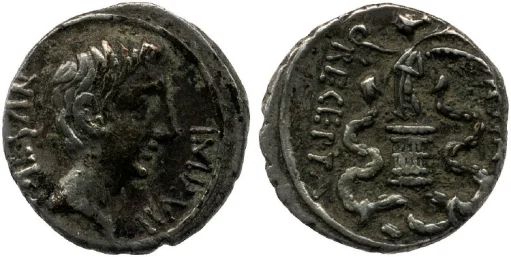
Coin of 29-27 BC Celebrating the Return of Asia to Rome’s control (British Museum)
Octavian continued to be the dominant figure, and celebrated as such.
One may note that on the aureus of 28 BC it is Octavian and Octavian alone who returns the rights and laws. On a coin of about the same date, celebrating Rome’s recapture of Asia (from Marc Antony), it is Octavian’s head that appears on the coin.
There is no sign of Agrippa. There seems to have been no pretence that Octavian’s power was shared or constitutional.